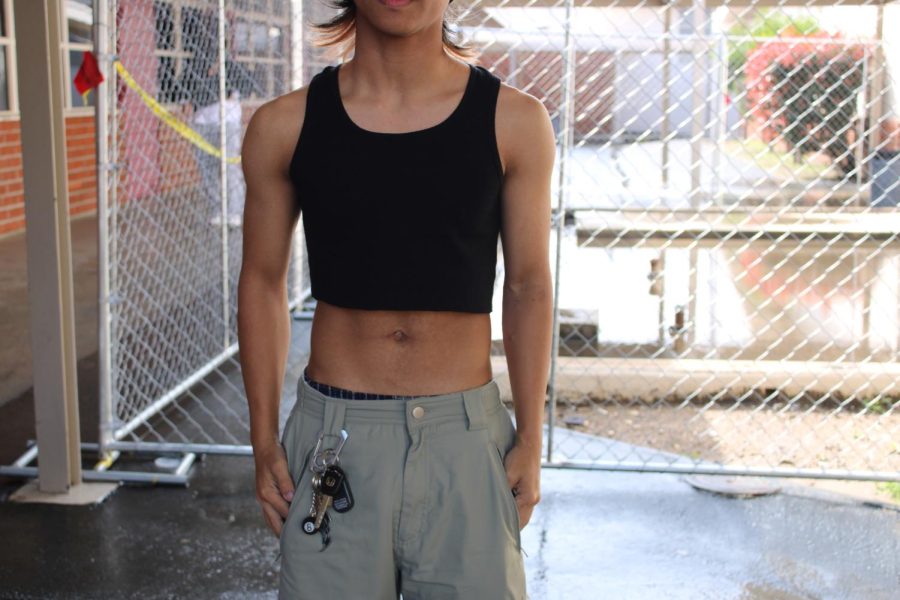Dress code feeds into harmful stereotypes
Female students model the insecurity that dress code inflicts. “I was showing like an inch or probably less of my stomach, which to me didn’t feel distracting at all, and it became a problem,” said Isabella Martinez.
April 6, 2023
Every morning, students face the daunting task of deciding what to wear. While some may spend less than a minute weighing their options, others spend multiple and others plan the night before. As fashion trends change throughout generations, clothing styles and trends have transformed drastically. A stricken rule, however, that has proved controversial for decades and affects students’ daily clothing choices is dress code.
Student dress code for the most part is an easy compliance with understandable guidelines that ban gang-related or discriminatory clothing. However, one rule that has exemplified controversy is the prohibition of bare abdomens, used interchangeably as midsections and stomachs.
In an interview with Assistant Superintendent of Education Denise Knutsen, she clarified that the dress code is necessary to prevent students from creating a distracting scene in learning environments. She declined to give an official statement.
WCUSD student representatives and teachers revised the dress code, condensing a 10-page document consisting of rules against spaghetti straps, pajamas, and more to one page of three rules banning profane jewelry or clothing, inappropriate shoes and bare abdomen.
Cutting down the rules was a significant part in updating the new policy. English and AVID teacher Lyndie Lorenger was a part of the dress code committee and attended meetings last school year. She explained the importance of updating these dress code policies to fit today’s generation.
“We started by looking at what the current dress code was and recognized that it was incredibly outdated. It was the same dress code that was enforced when I was a student here at West Covina High School and graduated in 1997,” said Lorenger.
Although the dress code was updated, it continues to be an issue for teachers and students.
“It makes us very uncomfortable having to enforce it. I feel that I am commenting to a student’s body, talking about the issue of what they are wearing,” said Lorenger.
Why do revealing midsections continuously cause discomfort? This issue centers around the fact that teenage girls feel that these rules target their bodies more in comparison to boys.
Juniors Isabella Martinez and Isabelle Gutierrez were two of the many female students who revealed an inch of their midsections and resulted in a dress code violation.
“I honestly just felt really embarrassed in the moment and felt uncomfortable within my own skin. Like, I was showing like an inch or probably less of my stomach, which to me didn’t feel distracting at all, and it became a problem,” said Martinez.
Gutierrez was dress coded not once, but twice due to her midsection. She expressed that dress codes can imply that women’s natural bodies are inappropriate, affecting real life challenges such as self-image and insecurity that are often overlooked.
“Even outside of school that follows you because you start to associate your own body with negativity. I feel like even the phrase that ‘things can be distracting’, we never apply that same energy towards men or the male student body,” said Gutierrez.
With the guidelines and policies implemented to set boundaries, this has prompted teenage girls to believe their own bodies are deemed distracting to people.
Following an August 2022 Insight article, New year, new policies, that provided information on the new dress code, senior Gavin Flores conducted a social experiment. Every day for two weeks Flores attended school wearing a crop top, revealing his torso and midsection. The verdict? Zero dress code violations or disciplinary actions.
“Unsurprisingly I wore the crop top on multiple occasions, passing by multiple administrators and teachers that did not take any action at all,” said Flores.
Flores’s purpose in conducting the social experiment was to prove the double standard when it came to clothing on campus. It started out as many of Flores’ female friends began getting dress-coded for minimal skin reveal. Alongside Flores, male students have been seen frequently around campus shirtless during and after sports activities. Inappropriate shirts picturing explicit text and images have also been dormant to dress code violations, yet a girl revealing her stomach is where the line is drawn.
Principal Dr. Charles Park explained that West Covina High School can be complex, and the dress code may be successful if translated correctly.
“It can teach our students professionalism in a place of learning and to teach those same soft skills as they enter the real world- that’s the intention. At the same time, I want students to feel comfortable on this campus, and there’s nothing more important than that,” said Park.
It is undeniable that dress code is necessary for a learning environment, but it poses the question of what is actually distracting and inappropriate. Disciplinary action against female students who show 1-2 inches of their midsections reinforces the stereotype that women must cover up for men instead of holding men accountable for sexualizing them. This is damaging as it teaches young women that their bodies are inherently inappropriate, and sends the message that men have control over a woman’s body; the mass majority of dress code violations handed out are by women on the behalf of men who are fearful to say anything themselves. Additionally, it enforces the idea that teenagers are valued more based on how much they conform to societal views, even if those views are damaging.
Although school-wide dress code enforcement has decreased, the issue at hand is much more complex.





